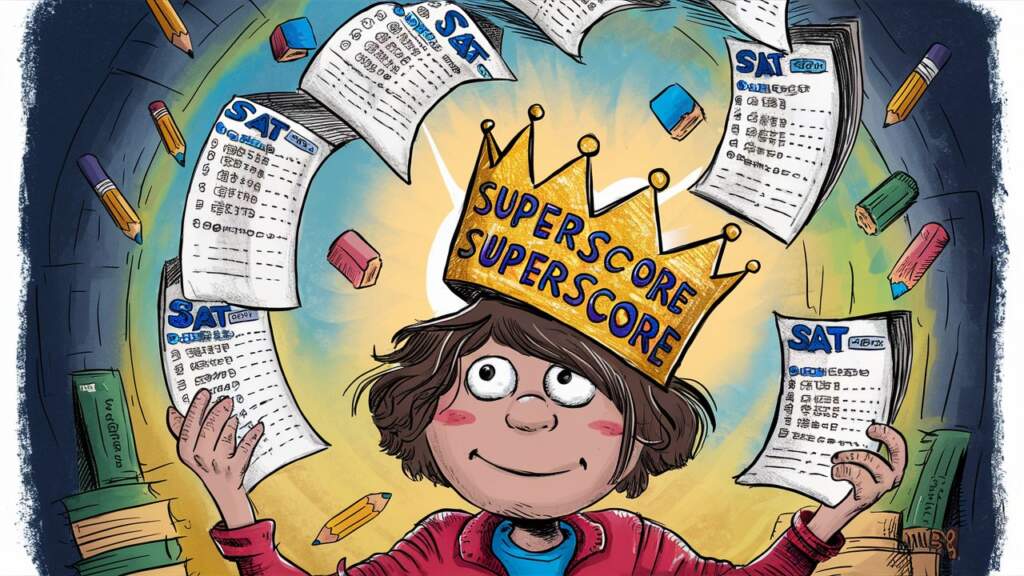Introduction
Super-score can help you make the most out of your SAT attempts. The SAT is a standardized test used for college admissions in the U.S., assessing skills in reading, writing, and math. It consists of two main sections: Evidence-Based Reading and Writing (EBRW) and Math, each scored from 200 to 800. The total score ranges from 400 to 1600.
In addition, the optional Essay section is scored separately and does not affect the composite score. The SAT scoring process includes converting raw scores into scaled scores, ensuring fairness across different test versions.
In this blog, we’ll explore “super-scoring,” a method that allows students to combine their best section scores from multiple SAT attempts to enhance their overall score. Understanding super-scoring can help you make the most of your SAT efforts and improve your college application prospects.
Want to familiarize yourself with the Digital SAT? Check out our blog article on The New Digital SAT Format
What is a Super-score?
Definition and Explanation
Super-scoring is a method used by some colleges and universities to evaluate a student’s best possible scores across multiple SAT test dates. Rather than considering a student’s highest total score from a single test administration, super-scoring combines the highest section scores from different test attempts to create a new, higher composite score.
Explanation of Super-scoring
The idea behind super-scoring is to provide a more accurate representation of a student’s abilities by showcasing their best performance in each section of the SAT. For example, if a student scores higher in the Evidence-Based Reading and Writing (EBRW) section on one test date and higher in the Math section on another, supers-coring allows colleges to combine these top scores into a single, higher composite score.
How Super-scoring Works
Here’s a step-by-step look at how super-scoring typically works:
- Multiple Test Attempts: A student takes the SAT on several occasions.
- Section Scores: After each test, the student receives individual scores for the EBRW and Math sections.
- Best Scores Selection: For each section, the highest scores from all test attempts are selected.
- Combining Scores: These highest section scores are then combined to form a new super-score. This new score reflects the student’s best performance across all test dates.
Colleges that use super-scoring will consider this combined score instead of just the highest total score from a single test. This approach can be particularly beneficial for students who may have performed unevenly across different test dates but achieved their best scores in specific sections.
How to Calculate Your Super-score
Step-by-Step Guide
Calculating your super-score involves combining your highest section scores from multiple SAT test attempts. Here’s a step-by-step guide to help you determine your super-score:
Gather Your SAT Scores
- Collect the section scores from all of your SAT test dates. For each test date, you will have scores for the Evidence-Based Reading and Writing (EBRW) section and the Math section.
Identify the Highest Scores for Each Section
- For each section (EBRW and Math), determine the highest score you achieved across all test dates.
Example:
- Test Date 1: EBRW = 720, Math = 750
- Test Date 2: EBRW = 740, Math = 720
- Test Date 3: EBRW = 710, Math = 730
From the scores above:
- Highest EBRW score = 740 (from Test Date 2)
- Highest Math score = 750 (from Test Date 1)
Combine the Highest Section Scores
- Create your super-score by combining the highest scores from each section.
Example:
- Highest EBRW score: 740
- Highest Math score: 750
- Super-score Composite: 740 (EBRW) + 750 (Math)
Calculate the Composite Super-score
- Add the highest section scores to get your composite super-score.
Example:
- Super-score Composite = 740 (EBRW) + 750 (Math) = 1490
Verify with College Requirements
- Check the specific super-scoring policies of the colleges you are applying to, as some may have different ways of calculating or reporting super-scores.
Conclusion
Recap of Key Points
Super-scoring is a method that allows colleges to combine your highest section scores from multiple SAT test attempts into a single, higher composite score. This approach can help you maximize your potential by reflecting your best performance in each section, regardless of when those scores were achieved. By understanding how super-scoring works and leveraging it effectively, you can improve your overall SAT score and enhance your college application.
To calculate your super-score, gather your highest section scores from each test date, combine them, and add them together to get your super-score. Remember, super-scoring policies can vary among colleges, so it’s important to verify each institution’s specific practices.
Final Advice for Students Considering Super-scoring
- Plan Your Test Dates: Consider taking the SAT more than once to give yourself the best chance to achieve high scores in different sections. Super-scoring allows you to capitalize on your strengths across multiple test dates.
- Focus on Weak Areas: Use your practice tests and previous scores to identify areas for improvement. Retaking the SAT to improve specific section scores can be beneficial.
- Check College Policies: Research the super-scoring policies of the colleges you’re interested in to ensure they use this method. Some schools may have different policies or may not super-score at all.
- Prepare Thoroughly: Invest time in studying and practicing for the SAT. Effective preparation will increase your chances of achieving higher section scores, which can enhance your super-score.
Read further: Is Digital SAT easier than the pen-and-paper version?
FAQs : Frequently Asked Questions
Q. Can You Super-score Digital and Paper SAT?
Yes, you can super-score both digital and paper SAT scores. Super-scoring combines the highest section scores from multiple test attempts, regardless of whether those attempts were taken digitally or on paper. The key factor is that the highest scores in each section are combined to form a new super-score, providing a better reflection of your abilities.
Q. How to super-score SAT?
To super-score the SAT, follow these steps:
- Collect Scores: Gather the section scores from all your SAT test dates, whether taken digitally or on paper.
- Identify Highest Scores: Determine the highest scores you achieved in each section (Evidence-Based Reading and Writing (EBRW) and Math) across all test dates.
- Combine Scores: Combine these highest section scores to create your super-score.
- Verify Policies: Check the specific super-scoring policies of the colleges you are applying to, as they may vary.
Q. How is score choice different from super-score?
Score choice gives students an option to select which score they would like to submit in their college applications.
Q. Can You Super-score SAT?
Yes, you can super-score the SAT, but it depends on the policies of the colleges to which you are applying. Super-scoring is a practice used by many institutions to consider the highest section scores from multiple test dates, but not all colleges use this method. It’s important to confirm with each college to see if they accept and use super-scoring.
Q. What is SAT Super-score?
SAT super-score is a method used by some colleges to combine the highest section scores from different SAT test dates to create a new, higher composite score. This approach allows students to showcase their best performance in each section, even if those scores were achieved on separate test dates. For instance, if you score exceptionally well in Math on one test date and in EBRW on another, super-scoring combines these top scores to enhance your overall SAT score.
Read further: How to get a perfect in SAT Math




